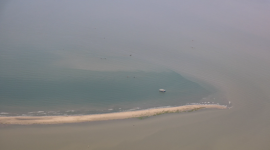|  | | 8 Beaches with an E. coli Advisory: Backbone Beach (Dundee, Delaware County, IA)*
Beed’s Lake Beach (Hampton, Franklin County, IA)*
Black Hawk Beach (Lake View, Sac County, IA)*
Lake Ahquabi Beach (Indianola, Warren County, IA)*
Lewis and Clark Beach (Blue Lake, Onawa, Monona County, IA)*
Lower Pine Lake Beach (Eldora, Hardin County, IA)*
Nine Eagles Beach (Davis City, Decatur County, IA)*
Union Grove Beach (Gladbrook, Tama County, IA)* 4 City and County Beaches exceed the state’s advisory threshold for E. coli.*
View the map on our website to see where they are. Note: Saylorville’s Oak Grove Beach is still closed due to high water. Monitoring has been suspended for the 2024 season at Lake Keomah due to renovation activities. *Data from the Iowa DNR State Park Beach Monitoring Program |
| IEC Publishes New White Paper on Drought and Drinking Water |
| Iowa just emerged from its longest period of drought since 1954-1959. Iowa’s average annual temperature is increasing and with annual precipitation down from 2020 to 2023, surface water and groundwater sources of drinking water were depleted. This left many communities across the state with impacted drinking water supplies. Residents in some communities were asked to reduce or eliminate non-essential water usage or switch to bottled water, while community leaders contemplated building new drinking water infrastructure to increase supplies. This cycle is expected to worsen – the National Oceanic and Atmospheric Administration (NOAA) predicts will we experience more frequent droughts as climate change is exacerbated in the coming years. As Iowa grapples with how to manage water resources in the face of drought and other extreme swings in weather due to climate change, the Iowa Environmental Council has published a new white paper: Drought and Iowa’s Drinking Water. The paper reviews drought vulnerabilities in Iowa, drought impacts on groundwater and surface water sources of drinking water, and mitigation and policy recommendations for managing future drought impacts. It also highlights the impacts that drought has had on drinking water in three Iowa communities in recent years: Belle Plaine, Osceola, and Des Moines. While we are recovering from drought now, it is wise to begin planning for, mitigating, and implementing policies to reduce the impacts of the next drought. We can mitigate future impacts by implementing nature-based solutions on the land in both urban and agricultural areas. This natural infrastructure, such as wetlands and drought-resistant native plantings, help retain water, allow greater water infiltration into the soil, and do not require irrigation. |
| |
|
| |  | |  | From Texas to Iowa: The Impact of Juneteenth Juneteenth (short for “June Nineteenth”) is a federal holiday commemorating the liberation of slaves in 1865. In early 1865, federal troops arrived in Texas, a state in defiance of President Abraham Lincoln’s ‘Emancipation Proclamation’ from two years prior due to little Union oversight. The 13th Amendment, formally abolishing slavery, was ratified in the Constitution on December 6, 1865. Juneteeth marked a time for celebration among the nearly 250,000 freed slaves in Texas, while hundreds of thousands of other slaves were freed across the country. On June 17, 2021, it officially became a federal holiday. In 1990, Gary Lawson founded Iowa Juneteeth Observance and offered a time to commemorate the important day in American history. In 2002, former Govenor Tom Vilsack established Juneteeth as an official day of recognition on the third Saturday in June. Celebrations take place throughout Iowa, and we encourage you to participate in your community’s events, whether it's a tour through the African American Museum of Iowa in Cedar Rapids, a Freedom 5K in Keokuk, or a live-music, family-friendly festival in Clinton. Read the entire blog on our website. |
|
|
 | ‘Dead zone’ in the Gulf of Mexico predicted to be bigger than average this summer The National Oceanic and Atmospheric Administration is forecasting the Dead Zone in the Gulf of Mexico will be 5,827 square miles this year, 5% larger than the long-term average. The "dead zone" forms in the Gulf every summer. It is caused by nutrients, primarily excess nitrogen and phosphorus, which are largely from farm fertilizer and municipal runoff that reach the Gulf of the Mississippi River. Algae feeds on those nutrients when it dies, bacteria deplete oxygen in the water, causing marine life to die or avoid the area. The U.S. Geological Survey (USGS) found that the amount of nitrates were below average and the amount of phosphorus was above average this year. "Lack of a downward trend in the dead zone illustrates that current efforts to reduce those loads have not been effective, "said Don Scavia, professor emeritus at University of Michigan. "Clearly, the federal and state agencies and Congress continue to prioritize industrial agriculture over water quality." Read the entire article by Eva Tesfaye on the New Orleans Public Radio website. | |
|
|
 | Farm to Trouble: A Series from the Ag & Water Desk This week, the Mississippi River Basin Ag & Water Desk published a series of stories entitled Farm to Trouble. The series examines what can be done to stem the flow of farm pollution that's choking the gulf. As reported in a series of five stories, government agencies set targets to fix the problem but, despite more than a quarter-century of federal efforts and billions in investment, advocates, scientists and regulators say the basin is "not even close" to those targets. Farm to Trouble stories look at progress on farm conservation practices, the environmental and political landscape in Louisiana, impacts of pollution on Upper Mississippi River states, a comparison of approaches to the dead zones in the Chesapeake Bay and Gulf, and the role of tile drainage in delivering farm pollution to the Mississippi River. The Ag & Water Desk is an independent journalism collective based at the University of Missouri in partnership with Report for America. Read more about this series from the Mississippi River Basin Ag & Water Desk on their website. |
|
|
| |  | | What's new in Iowa's water news: |
|
|
| | |  | | | Iowa Environmental Council
505 Fifth Ave., Suite 850
Des Moines, Iowa 50309-2317
515-244-1194 | iecmail@iaenvironment.org |
|
|
|
|
|